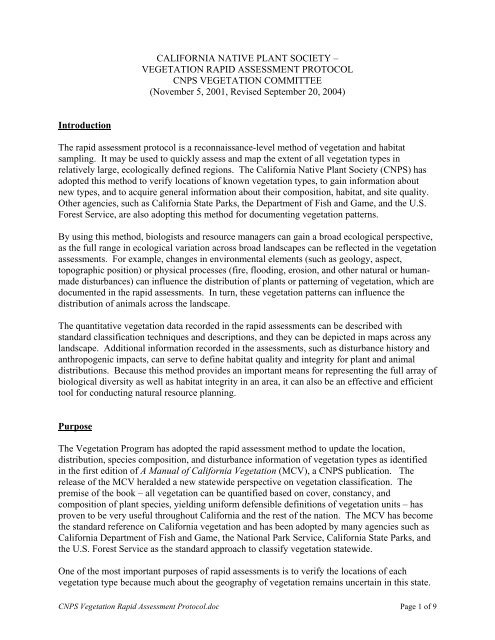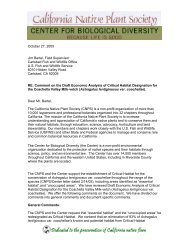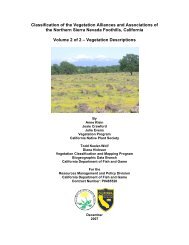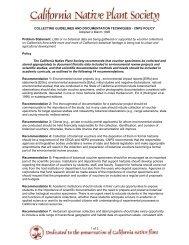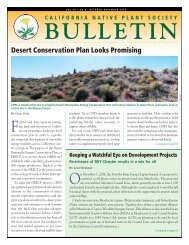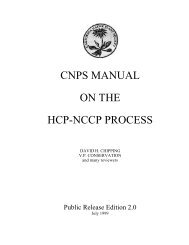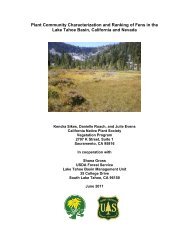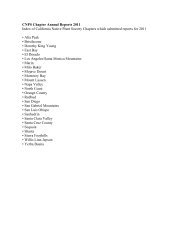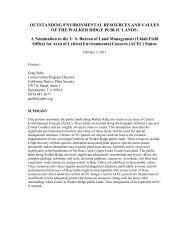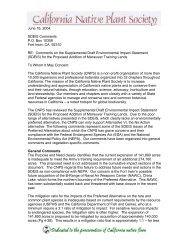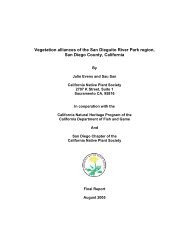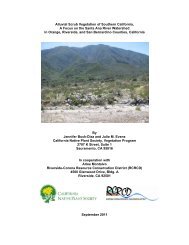CNPS Vegetation Rapid Assessment Protocol - California Native ...
CNPS Vegetation Rapid Assessment Protocol - California Native ...
CNPS Vegetation Rapid Assessment Protocol - California Native ...
You also want an ePaper? Increase the reach of your titles
YUMPU automatically turns print PDFs into web optimized ePapers that Google loves.
To obtain a more accurate understanding of the location and distribution of the vegetation types,nothing short of systematic inventory will suffice. Using the rapid assessment method, <strong>CNPS</strong>Chapters and other organizations can work together in selected ecological regions to gathervegetation data over a short time period in a broad area. This geographic inventory of vegetationtypes can greatly advance the current distribution understanding of vegetation.In addition, <strong>California</strong> is working with a new vegetation classification, and its parameters arelargely untested. The rapid assessment method will be used to gather additional information onspecies composition, distribution, disturbance effects, and environmental influences ofvegetation. Thus, this method will provide modifications to the existing vegetationclassifications and information on new types.This protocol can also be used in tandem with other resource assessment protocols such aswildlife assessments or aquatic/stream assessments. For example, the <strong>California</strong> WildlifeHabitat Relationships (CWHR) protocols have been used in conjunction with the vegetationassessment protocol to obtain detailed records on habitat quality and suitability for vertebrateanimals in terrestrial habitats. The CWHR protocols can also help test the relationships betweenthe vegetation type and habitat of various animals and thereby refine the understanding andpredictability of the distribution of animals. A portion of the CWHR protocols is incorporatedinto the rapid assessment method to obtain suitability information for vertebrate species.While people can quickly obtain information on the variety of vegetation types using thismethod, some of the vegetation types recorded in the rapid assessment process may be poorlydefined in the current classification system. These poorly understood or unknown types will beidentified and located and then will be prioritized for more detailed assessment using the <strong>CNPS</strong>relevé protocol. Thus, the rapid assessment method will be used in conjunction with the relevémethod to provide large quantities of valuable data on the distribution and the definition ofvegetation. These data will be entered into existing databases for summarizing and archiving,and they will be used to modify and improve statewide vegetation classification and conservationinformation.Why do we need to know about the composition and distribution of vegetation?• to have a more accurate understanding of the commonness and rarity of different forms ofvegetation throughout the state• to link the distribution of various rare and threatened plant species with the vegetation units• to provide a clearer picture of relationships between vegetation types• to help prioritize community-based land conservation goals based on the local representationof unique types, high diversity areas, etc.• to do the same for regional vegetation throughout the state and the nation.• to broaden the vegetation knowledge base for <strong>California</strong>• to motivate people to do more to help identify, protect, and conserve vegetation in their area• to link vegetation types with habitat for animals<strong>CNPS</strong> <strong>Vegetation</strong> <strong>Rapid</strong> <strong>Assessment</strong> <strong>Protocol</strong>.doc Page 2 of 9
Selecting stands to sample:To start the rapid assessment method, stands of vegetation needs to be defined.A stand is the basic physical unit of vegetation in a landscape. It has no set size. Somevegetation stands are very small, such as alpine meadow or tundra types, and some may beseveral square kilometers in size, such as desert or forest types. A stand is defined by two mainunifying characteristics:1) It has compositional integrity. Throughout the site, the combination of species is similar.The stand is differentiated from adjacent stands by a discernable boundary that may beabrupt or indistinct.2) It has structural integrity. It has a similar history or environmental setting that affordsrelatively similar horizontal and vertical spacing of plant species. For example, a hillsideforest originally dominated by the same species that burned on the upper part of theslopes, but not the lower, would be divided into two stands. Likewise, a sparse woodlandoccupying a slope with very shallow rocky soils would be considered a different standfrom an adjacent slope with deeper, moister soil and a denser woodland or forest of thesame species.The structural and compositional features of a stand are often combined into a term calledhomogeneity. For an area of vegetated ground to meet the requirements of a stand, it must behomogeneous.Stands to be sampled may be selected by evaluation prior to a site visit (e.g. delineated fromaerial photos or satellite images), or they may be selected on site (during reconnaissance todetermine extent and boundaries, location of other similar stands, etc.).Depending on the project goals, you may want to select just one or a few representative stands ofeach homogeneous vegetation type for sampling (e.g. for developing a classification for avegetation mapping project), or you may want to sample all of them (e.g. to define a rarevegetation type and/or compare site quality between the few remaining stands).<strong>CNPS</strong> <strong>Vegetation</strong> <strong>Rapid</strong> <strong>Assessment</strong> <strong>Protocol</strong>.doc Page 3 of 9
Definitions of fields in the protocolLOCATIONAL/ENVIRONMENTAL DESCRIPTIONPolygon/Stand #: Number assigned either in the field or in the office prior to sampling. It isusually denoted with an abbreviation of the sampling location and then a sequential number ofthat locale (e.g. CRRA-001 for Coyote Ridge rapid assessment number 1).Air photo #: The number given to the aerial photo in a vegetation-mapping project, for whichphoto interpreters have already done photo interpretation and delineations of polygons. If thesample site has not been photo-interpreted, leave blank.Date: Date of the sampling.Name(s) of surveyors: The full names of each person assisting should be provided for the firstrapid assessment. In successive assessments, initials of each person assisting can be recorded.Please note: The person recording the data on the form should circle their name/initials.GPS waypoint #: The waypoint number assigned by a Global Positioning System (GPS) unitwhen marking and storing a waypoint for the stand location. These waypoints can bedownloaded from the GPS into a computer Geographic Information System to depict samplepoints accurately on a map.GPS name: The name personally assigned to each GPS unit (especially useful if more than oneGPS unit is used to mark waypoints for the project).GPS datum: (NAD 27) The map datum that is chosen for GPS unit to document locationcoordinates. The default datum for <strong>CNPS</strong> projects is NAD 27. However, other agencies andorganizations may prefer another datum. Please circle NAD27 or write in the appropriate datum.Is GPS within stand? Yes / No Circle“Yes” to denote that the GPS waypoint was takendirectly within or at the edge of the stand being assessed, or circle “No” to denoted the waypointwas taken at a distance from the stand (such as with a binocular view of the stand).If No cite distance (note ft/m), bearing and view from point to stand: An estimate of thenumber of feet or meters (please circle appropriate), the compass bearing from the waypoint ofGPS to the stand, and the method of view used to verify the plot (e.g. binoculars, aerial photo).Error: ± The accuracy of the GPS location, when taking the UTM field reading. Please denotefeet (ft) or meters (m). It is typical for all commercial GPS units to be accurate to within 5 m (or16 ft.) of the actual location, because the military’s intentional imprecision (known as “selectiveavailability”) has been “turned off” as of July 2000. Please become familiar with your GPSunit’s method of determining error. Some of the lower cost models do not have this ability. Ifusing one of those, insert N/A in this field.<strong>CNPS</strong> <strong>Vegetation</strong> <strong>Rapid</strong> <strong>Assessment</strong> <strong>Protocol</strong>.doc Page 4 of 9
UTM field reading: Easting (UTME) and northing (UTMN) location coordinates using theUniversal Transverse Mercator (UTM) grid. Record using a GPS unit or USGS topographic map.UTM zone: Universal Transverse Mercator zone. Zone 10S for <strong>California</strong> west of the 120 thlongitude; zone 11S for <strong>California</strong> east of 120 th longitude.Elevation: Recorded from the GPS unit or USGS topographic map. Please denote feet (ft) ormeters (m), and note if reading is from GPS unit or map. (Please note: Readings taken from aGPS unit can be hundreds of feet off.)Photograph #’s: Note the roll number, frame number, direction, and the name of the personwhose camera is being used. Take at least two photographs from different directions, anddescribe the location and view direction from compass bearings for each frame. Additionalphotographs of the stand may also be helpful. (Also, if using a digital camera or scanning theimage into a computer, positions relative to the polygon/stand number can be recorded digitally.)Topography: Check two of the provided features, characterizing both the local relief and thebroad topographic position of the area. First assess the minor topographic features or the lay ofthe area (e.g. surface is flat, concave, etc.). Then assess the broad topographic feature or generalposition of the area (e.g. stand is at the bottom, lower (1/3 of slope), middle (1/3 of slope), upper(1/3 of slope), or top).Geology: Geological parent material of site. If exact type is unknown, use a more generalcategory (e.g. igneous, metamorphic, sedimentary). See code list for types.Soil: Record soil texture or series that is characteristic of the site (e.g. sand, silt, clay, coarseloamy sand, sandy clay loam, saline, et.). See soil texture key and code list for types.Rock: %Large (optional): Estimate the percent surface cover of large rocks (e.g. stones,boulders, bedrock) that are beyond 25 cm in size.Rock:%Small (optional): Estimate the percent surface cover of small rocks (e.g. gravel,cobbles) that are greater than 2 mm and less than 25 cm in size.%Bare/Fines (optional): Estimate the percent surface cover of bare ground and fine sediment(e.g. dirt) that is 2 mm or less in size.%Litter (optional): Estimate the percent surface cover of litter, duff, or wood on the ground.%BA Stems (optional): Estimate the percent surface cover of the plant basal area, i.e., the basalarea of stems at the ground surface.General slope exposure (circle one and enter actual º): Read degree aspect from a compass orclinometer (or estimate). Make sure to average the reading across entire stand. “Variable” maybe selected if the same, homogenous stand of vegetation occurs across a varied range of slopeexposures.<strong>CNPS</strong> <strong>Vegetation</strong> <strong>Rapid</strong> <strong>Assessment</strong> <strong>Protocol</strong>.doc Page 5 of 9
General slope steepness (circle one and enter actual º): Read degree slope from compass (orestimate), using degrees from true north (adjusting for declination). Average the reading overentire stand.Upland or Wetland/Riparian (circle one): Indicate if the stand is in an upland or a wetland;note that a site need not be officially delineated as a wetland to qualify as such in this context(e.g. seasonally wet meadow).Site history, stand age, and comments: Briefly describe the stand age/seral stage, disturbancehistory, nature and extent of land use, and other site environmental and vegetation factors.Examples of disturbance history: fire, landslides, avalanching, drought, flood, animal burrowing,or pest outbreak. Also, try to estimate year or frequency of disturbance. Examples of land use:grazing, timber harvest, or mining. Examples of other site factors: exposed rocks, soil with finetexturedsediments, high litter/duff build-up, multi-storied vegetation structure, or other standdynamics.Type / level of disturbance (use codes): List codes for potential or existing impacts on thestability of the plant community. Characterize each impact each as L (=Light), M (=Moderate),or H (=Heavy). See code list for impacts.VEGETATION DESCRIPTIONBasic alliance and stand descriptionField-assessed vegetation alliance name: Name of alliance (series) or habitat following the<strong>CNPS</strong> classification system (Sawyer and Keeler-Wolf 1995). Please use binomial nomenclature,e.g. Quercus agrifolia forest. An alliance is based on the dominant (or diagnostic) species of thestand, and is usually of the uppermost and/or dominant height stratum. A dominant speciescovers the greatest area (and a diagnostic is consistently found in some vegetation types but notothers).Please note: The field-assessed alliance name may not exist in present classification, in whichyou can provide a new alliance name in this field. If this is the case, also make sure to denoteand explain this in the “Cannot identify alliance based on MCV classification” of the “Problemswith Interpretation” section below.Field-assessed association name (optional): Name of the species in the alliance and additionaldominant/diagnostic species from any strata, as according to <strong>CNPS</strong> classification. In followingnaming conventions, species in differing strata are separated with a slash, and species in theuppermost stratum are listed first (e.g. Quercus agrifolia/Toxicodendron diversilobum). Speciesin the same stratum are separated with a dash (e.g. Quercus agrifolia-Quercus kelloggii).Please note: The field-assessed association name may not exist in present classification, inwhich you can provide a new association name in this field.Size of stand: Estimate the size of the entire stand in which the rapid assessment is taken. As ameasure, one acre is about 0.4 hectares or about 4000 square meters.<strong>CNPS</strong> <strong>Vegetation</strong> <strong>Rapid</strong> <strong>Assessment</strong> <strong>Protocol</strong>.doc Page 6 of 9
%Overstory Conifer/Hardwood Tree cover: The total aerial cover (canopy closure) of all livetree species that are specifically in the overstory or are emerging, disregarding overlap ofindividual trees. Estimate conifer and hardwood covers separately. Please note: These covervalues should not include the coverage of suppressed understory trees.Shrub cover: The total aerial cover (canopy closure) of all live shrub species, disregardingoverlap of individual shrubs.Ground cover: The total aerial cover (canopy closure) of all herbaceous species, disregardingoverlap of individual herbs.Total Veg cover: The total aerial cover of all vegetation. This is an estimate of the absolutevegetation cover, disregarding overlap of the various tree, shrub, and/or herbaceous layers.Modal height for conifer/hardwood tree, shrub, and herbaceous categories (optional)If height values are important in your vegetation survey project, provide an ocular estimate ofheight for each category listed. Record an average height value, estimating the modal height foreach group. Use the following height intervals and record a height class: 01=50m.Species list and coverageSpecies (List up to 12 major species), Stratum, and Approximate % cover: (Jepson Manualnomenclature please)List the species that are dominant or that are characteristically consistent throughout the stand.When different layers of vegetation occur in the stand, make sure to list species from eachstratum. As a general guide, make sure to list at least 1-2 of the most abundant species perstratum. Provide a stratum code for each species listed, based on height, where T (=Tall) is >5 min height, M (=Medium) is between 0.5 and 5 m in height, and L (=Low) is 15-25%, >25-50%, >50-75%, >75%). Keeping these classesin mind, then refine your estimate to a specific percentage (e.g the cover of species “x” issomewhere between 25 and 50 percent, but I think it is actually around 30%). Please note: Allestimates are to be reported as absolute cover (not relative cover), and all the species percentcovers may total over 100% when added up because of overlap.Major non-native species in stand (with % cover): All exotic species occurring in the standshould be listed in this space provided (or they can be recorded in the above Species list). Makesure to give each exotic species an absolute coverage estimate.Unusual species: List species that are either locally or regionally rare, endangered, or atypical(e.g. range extension or range limit) within the stand. This species list will be useful to theProgram for obtaining data on regionally or locally significant populations of plants.<strong>CNPS</strong> <strong>Vegetation</strong> <strong>Rapid</strong> <strong>Assessment</strong> <strong>Protocol</strong>.doc Page 8 of 9
PROBLEMS WITH INTERPRETATIONConfidence in Identification: (L, M, H) With respect to the “field-assessed alliance name”,note whether you have L (=Low), M (=Moderate), or H (=High) confidence in the interpretationof this alliance name. Low confidence can occur from such things as a poor view of the stand,an unusual mix of species that does not meet the criteria of any described alliance, or a lowconfidence in your ability to identify species that are significant members of the stand.Explain: Please elaborate if your “Confidence in Identification” is low or moderate. Similarly,if the field-assessed alliance name is not defined by <strong>CNPS</strong>’s present Manual of <strong>California</strong><strong>Vegetation</strong> (MCV) classification, note this in the space and describe why. In some instances forspecific projects, there may be the benefit of more detailed classifications than what is presentedin the first edition of the MCV. If this is the case, be sure to substitute the most appropriate anddetailed classification.Other identification problems (describe): Discuss any further problems with the identificationof the assessment (e.g. stand is observed with an oblique view using binoculars, so the specieslist may be incomplete, or the cover percentages may be imperfect).Polygon is more than one type (Yes, No) (Note: type with greatest coverage in polygon shouldbe entered in above section) This is relevant to areas that have been delineated as polygons onaerial photographs for a vegetation-mapping project. In most cases the polygon delineated isintended to represent a single stand, however mapping conventions and the constraints andinterpretability of remote images will alter the ability to map actual stands on the ground. “Yes”is noted when the polygon delineated contains the field-assessed alliance and other vegetationtype(s), as based on species composition and structure. “No” is noted when the polygon isprimarily representative of the field-assessed alliance.Other types: If “Yes” above, then list the other subordinate vegetation alliances that areincluded within the polygon. List them in order of their amount of the polygon covered.Has the vegetation changed since air photo taken? (Yes, No) If an aerial photograph isbeing used for reference, evaluate if the stand of the field-assessed alliance has changed as aresult of disturbance or other historic change since the photograph was taken.If Yes, how? What has changed (write N/A if so)? If the photographic signature of thevegetation has changed (e.g. in structure, density, or extent), please detail here.<strong>CNPS</strong> <strong>Vegetation</strong> <strong>Rapid</strong> <strong>Assessment</strong> <strong>Protocol</strong>.doc Page 9 of 9
Simplified Key to Soil Texture (Brewer and McCann, 1982)Place about three teaspoons of soil in the palm of your hand. Take out any particles
CALIFORNIA NATIVE PLANT SOCIETY RELEVÉ FIELD FORM CODE LIST(revised 7/8/02)IMPACTS01 Development02 ORV activity03 Agriculture04 Grazing05 Competition from exotics06 Logging07 Insufficient population/stand size08 Altered flood/tidal regime09 Mining10 Hybridization11 Groundwater pumping12 Dam/inundation13 Other14 Surface water diversion15 Road/trail construction/maint.16 Biocides17 Pollution18 Unknown19 Vandalism/dumping/litter20 Foot traffic/trampling21 Improper burning regime22 Over collecting/poaching23 Erosion/runoff24 Altered thermal regime25 Landfill26 Degrading water quality27 Wood cutting28 Military operations29 Recreational use (non ORV)30 Nest parasitism31 Non-native predators32 Rip-rap, bank protection33 Channelization (human caused)34 Feral pigs35 Burros36 Rills37 Phytogenic moundingMACRO TOPOGRAPHY00 Bench01 Ridge top (interfluve)02 Upper 1/3 of slope03 Middle 1/3 of slope04 Lower 1/3 of slope (lowslope)05 Toeslope (alluvial fan/bajada)06 Bottom/plain07 Basin/wetland08 Draw09 Other10 Terrace (former shoreline or floodplain)11 Entire slope12 Wash (channel bed)13 Badland (complex of draws & interfluves)14 Mesa/plateau15 Dune/sandfield16 Pediment17 Backslope (cliff)MICRO TOPOGRAPHY01 Convex or rounded02 Linear or even03 Concave or depression04 Undulating pattern05 Hummock or Swale pattern06 Mounded07 OtherPARENT MATERIALANDE AndesiteASHT Ash (of any origin)GRAN Granitic (generic)GREE GreenstoneDIOR DioriteBASA BasaltOBSI ObsidianPUMI PumiceIGTU Igneous (type unknown)MONZ MonzonitePYFL Pyroclastic flowQUDI Quartz dioriteRHYO RhyoliteVOLC General volcanic extrusivesVOFL Volcanic flowVOMU Volcanic mudBLUE Blue schistCHER ChertDOLO DolomiteFRME Franciscan melangeINTR General igneous intrusivesGNBG Gneiss/biotite gneissHORN HornfelsMARB MarbleMETU Metamorphic (type unknown)PHYL PhylliteSCHI SchistSESC Semi-schistSLAT SlateBREC Breccia (non-volcanic)CACO Calcareous conglomerateCASA Calcareous sandstoneCASH Calcareous shaleCASI Calcareous siltstoneCONG ConglomerateFANG FanglomerateGLTI Glacial till, mixed origin, moraineLALA Large landslide (unconsolidated)LIME LimestoneSAND SandstoneSETU Sedimentary (type unknown)SHAL ShaleSILT SiltstoneDIAB DiabaseGABB GabbroPERI PeridotiteSERP SerpentineULTU Ultramafic (type unknown)CALU Calcareous (origin unknown)DUNE Sand dunesLOSS LoessMIIG Mixed igneousMIME Mixed metamorphicMIRT Mix of two or more rock typesMISE Mixed sedimentaryCLAL Clayey alluviumGRAL Gravelly alluviumMIAL Mixed alluviumSAAL Sandy alluvium (most alluvial fansand washes)SIAL Silty alluviumOTHE Other than on listSOIL TEXTURECOSA Coarse sandMESN Medium sandFISN Fine sandCOLS Coarse, loamy sandMELS Medium to very fine, loamy sandMCSL Moderately coarse, sandy loamMESA Medium to very fine, sandy loamMELO Medium loamMESL Medium silt loamMESI Medium siltMFCL Moderately fine clay loamMFSA Moderately fine sandy clay loamMFSL Moderately fine silty clay loamFISA Fine sandy clayFISC Fine silty clayFICL Fine claySAND Sand (class unknown)LOAM Loam (class unknown)CLAY Clay (class unknown)UNKN UnknownPEAT PeatMUCK MuckDOMINANT VEGETATION GROUPTrees:TBSE Temperate broad-leaved seasonalevergreen forestTNLE Temperate or subpolar needle-leafedevergreen forestCDF Cold-deciduous forestMNDF Mixed needle-leafed evergreen-colddeciduous. forestTBEW Temperate broad-leaved evergreenwoodlandTNEW Temperate or subpolar needle-leavedevergreen woodlandEXEW Extremely xeromorphic evergreenwoodlandCDW Cold-deciduous woodlandEXDW Extremely xeromorphic deciduouswoodlandMBED Mixed broad-leaved evergreen-colddeciduous woodlandMNDW Mixed needle-leafed evergreen-colddeciduous woodlandShrubs:TBES Temperate broad-leaved evergreenshrublandNLES Needle-leafed evergreen shrublandMIES Microphyllus evergreen shrublandEXDS Extremely xeromorphic deciduousshrublandCDS Cold-deciduous shrublandMEDSXMEDMixed evergreen-deciduous shrublandExtremely xeromorphic mixed evergreendeciduousshrublandDwarf Shrubland:NMED Needle-leafed or microphyllous evergreendwarf shrublandXEDS Extremely xeromorphic evergreen dwarfshrublandDDDS Drought-deciduous dwarf shrublandMEDD Mixed evergreen cold-deciduous dwarfshrublandHerbaceous:TSPG Temperate or subpolar grasslandTGST Temperate or subpolar grassland withsparse treeTGSS Temperate or subpolar grassland withsparse shrublayerTGSD Temperate or subpolar grassland withsparse dwarf shrub layerTFV Temperate or subpolar forb vegetationTHRV Temperate or subpolar hydromorphicrooted vegetationTAGF Temperate or subpolar annual grassland orforb vegetationSparse <strong>Vegetation</strong>:SVSD Sparsely vegetated sand dunesSVCS Sparsely vegetated consolidated substrates


